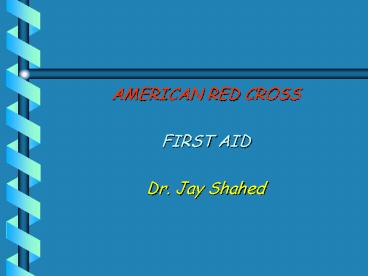AMERICAN RED CROSS - PowerPoint PPT Presentation
1 / 22
Title:
AMERICAN RED CROSS
Description:
AMERICAN RED CROSS. FIRST AID. Dr. Jay Shahed. FIRST AID. Dr. Jay Shahed. Injuries ... Elastic bandage ( ACE ) ( Sprains or Strains) Types of bleeding ... – PowerPoint PPT presentation
Number of Views:5246
Avg rating:3.0/5.0
Title: AMERICAN RED CROSS
1
- AMERICAN RED CROSS
- FIRST AID
- Dr. Jay Shahed
2
- FIRST AID
- Dr. Jay Shahed
3
Injuries
- 5 Leading causes to Injuries
- Motor - vehicle crashes
- Falls
- Poisonings
- Drownings
- Fires
4
The 5 major types of wounds
- Bruise
- Contusion, Charley Horse
- Scrape
- Abrasion, Road Rash, Rug burn, Strawberry
- Cut
- Incision, Laceration
- Avulsion
- Puncture
5
Treatment of a wound
- Open wounds
- Control bleeding
- Use pressure points
- Bandage
- types of bandage
- Roller Bandage ( Control bleeding )
- Elastic bandage ( ACE ) ( Sprains or Strains)
6
Types of bleeding
- External
- Apply pressure
- Elevate the arm
- Cover the dressing with roller bandage
- QUESTION?
- What would you do if bleeding does not stop?
7
Internal Bleeding
- Victim will have the following signs and symptoms
- Weakness
- Confusion
- Sweating
- Decreased blood pressure
- Paleness
8
Shocks
- Shocks is likely to develop in any serious injury
or illness. - The signals are
- Restlessness or irritability
- Altered consciousness
- Pale, cool,, moist skin
- Rapid breathing
- Rapid pulse
9
Burns
- Burns are caused by
- Heat
- Chemicals
- Electricity
- Radiation
10
Burns
- Critical burn
- can be life-threatening and needs immediate
medical attention. - Chemical burns
- should be flushed with large amounts of cool
running water until advanced medical help arrives.
11
- Never go near a victim of an electrical burn
until you are sure the victim is not still in
contact with the power source.
12
Injuries to Muscles, Bones, and Joints
- When a serious injury occurs, it is best not to
move the victim. - If you are going to move or transport the victim
apply a splint to the site injury. - Applying a splint can help minimize movement and
prevent the victim from further injury.
13
Care for Head and Spinal Injury
- The general care for spinal injuries includes
- Minimizing head and spine movement
- Maintaining an open airway
- Checking consciousness and breathing
- Controlling any external bleeding
- Keeping the victim from getting chilled or
overheated
14
Sudden Illnesses
- Most of sudden illnesses has common signals.
- Causes
- You will rarely know the exact cause of the
sudden illness, but this should not keep you from
providing the proper initial care.
15
- Poisoning
- More than 90 of all poisonings takes place at
home. - If you think someone has been poisoned, call 911
or poison control - Unconscious diabetic
- Give sugar
- Seizure victim
- protect them from injury.
16
- Vomiting victims
- Place victim on his or her side.
- Heat- or cold-related illness
- Both heat and cold emergencies can be prevented
by wearing proper clothing and minimizing
activity in extremely hot or cold environments.
17
Caring for Children
- Children have unique needs that require special
care. - Caring for an injured or ill child requires a
rescuer to recognize the childs fear and
anxiety.
18
- There are important characteristics to remember
when checking a child. - 5 guidelines to check a child
- Observe the child. Dont just rush up and touch
the child. - Remain calm. Children will be more upset if you
are excited.
19
Continue
- Remain calm. Children will be more upset if you
are excited. - Talk clearly and simply.
- Do not separate the child from their love ones.
- Gain trust through your actions
20
Caring for the elderly
- Care for the elderly requires that you keep in
mind special problems and concerns. - Often fear of loss of independence will cause an
elderly victim to avoid treatment.
21
- Do not talk down to an elderly victim as you
would a child. - The most important action you can take is to see
that if appropriate, the victim is taken to a
medical facility.
22
Common injuries to the elderly.
- Always suspect that the head, neck, back, or hip
are injured. - Realize that the signals of the seriousness of an
injury may not occur for days. Anyone close to
the victim should be alert to signals of unusual
behavior.































